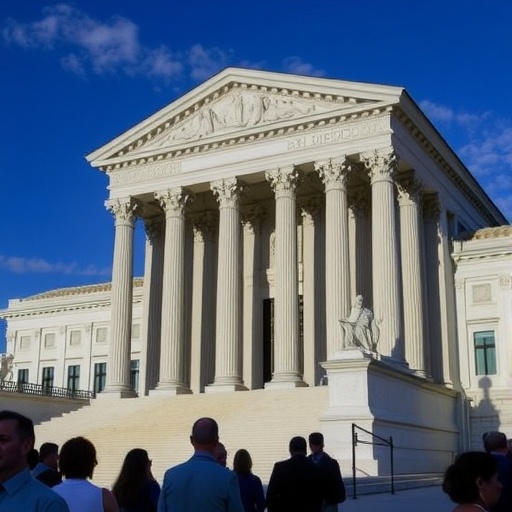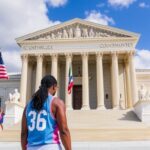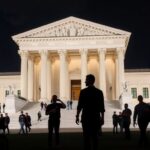In a decision that could reshape American democracy, the Supreme Court is poised to rule on a pivotal challenge to the Voting Rights Act, potentially dismantling protections against racial discrimination in redistricting and threatening minority representation in elections nationwide.
- Spotlight on the Case: Merrill v. Milligan Takes Center Stage
- Decoding Section 2: The Voting Rights Act‘s Anti-Discrimination Shield
- Redistricting Battles: How Racial Discrimination Shapes Electoral Maps
- Stakeholder Voices: Civil Rights Groups Rally Against Erosion
- Future Fallout: Implications for National and Local Democracy
Spotlight on the Case: Merrill v. Milligan Takes Center Stage
The Supreme Court heard oral arguments in Merrill v. Milligan on Tuesday, a high-stakes case originating from Alabama’s contentious congressional map. At issue is Section 2 of the Voting Rights Act, a cornerstone provision enacted in 1965 to combat racial discrimination in voting practices. Challengers argue that the law’s requirements for creating majority-minority districts unfairly force states to prioritize race in redistricting, potentially violating the Equal Protection Clause of the 14th Amendment.
Alabama’s map, drawn after the 2020 census, created just one majority-Black district out of seven, despite Black voters comprising 27% of the state’s population. Civil rights groups, including the NAACP, contend this dilutes minority representation by packing Black voters into a single district while spreading them thinly across others, effectively minimizing their electoral influence. The Eleventh Circuit Court of Appeals sided with the plaintiffs, ordering Alabama to redraw the map to include a second majority-Black district.
During arguments, Justice Elena Kagan pressed Alabama Solicitor General Edmund LaCour on the practicalities: “If race can’t be considered at all, how do you ensure fair representation?” LaCour responded that the state’s map was race-neutral, based on traditional districting criteria like compactness and contiguity. Yet, Justice Sonia Sotomayor highlighted historical patterns, noting, “This isn’t abstract; it’s a continuation of Jim Crow-era tactics to suppress Black votes.”
The case builds on the Court’s 2013 Shelby County v. Holder decision, which gutted Section 5’s preclearance formula, leaving Section 2 as the primary bulwark against discriminatory voting laws. With redistricting underway post-2020 census, this ruling arrives at a critical juncture, affecting not just congressional seats but state legislatures and local elections in battleground states.
Decoding Section 2: The Voting Rights Act‘s Anti-Discrimination Shield
Section 2 of the Voting Rights Act prohibits voting practices that dilute the voting strength of racial minorities. Enacted amid the Civil Rights Movement, it empowers courts to strike down redistricting plans that result in unequal electoral opportunities for protected groups, including Black, Latino, Asian American, and Native American voters.
Historically, the provision has been instrumental in challenging gerrymanders. For instance, in Thornburg v. Gingles (1986), the Supreme Court established a three-prong test for Section 2 claims: minorities must be sufficiently large and geographically compact to form a majority in a district; they must demonstrate political cohesion; and the majority must vote as a bloc to usually defeat minority-preferred candidates.
Statistics underscore its impact. According to the Brennan Center for Justice, between 1982 and 2020, Section 2 litigation led to the creation or preservation of over 150 majority-minority districts in congressional and state races. In the South, where racial discrimination in voting was rampant, these protections have boosted minority representation by 40% in state legislatures since the 1990s.
Yet, conservative justices, including Clarence Thomas and Samuel Alito, have long criticized Section 2 as encouraging racial gerrymandering. In Brnovich v. Democratic National Committee (2021), the Court curtailed its application to voting restrictions, signaling a narrowing scope. If Merrill v. Milligan succeeds for challengers, it could impose stricter standards, requiring plaintiffs to prove not just dilution but intentional discrimination—a higher bar that echoes the demise of other civil rights tools.
Civil rights attorney Debo Adegbile, former NAACP Legal Defense Fund director, warned in a recent interview, “Stripping Section 2 would invite a flood of discriminatory maps, eroding the progress of generations.” Data from the Princeton Gerrymandering Project supports this: in 2022, at least 10 states faced Section 2 challenges, resulting in fairer maps that enhanced minority representation in urban areas like Atlanta and Houston.
Redistricting Battles: How Racial Discrimination Shapes Electoral Maps
Redistricting, the once-a-decade process of redrawing electoral boundaries, is fertile ground for racial discrimination. Following the 2020 census, which revealed population shifts favoring diverse urban centers, states like Texas, Georgia, and Florida aggressively pursued maps that critics say pack and crack minority communities—concentrating them into fewer districts or dispersing them to weaken their voting power.
In Texas, a Section 2 lawsuit (LULAC v. Abbott) challenged maps that reduced Latino influence despite their 39% share of the population. The case, ongoing in federal court, illustrates how redistricting can perpetuate racial discrimination: Latino voters, who lean Democratic, were split across districts dominated by white Republicans, diluting their sway in congressional races.
Nationwide, the U.S. Census Bureau reports that people of color will comprise 57% of the population by 2045, yet without robust Voting Rights Act safeguards, minority representation could stagnate. A 2023 report by the National Conference of State Legislatures found that in 15 states, post-2020 redistricting decreased Black and Latino seats by an average of 12%, even as their populations grew.
Local elections face similar threats. In cities like Birmingham, Alabama, and Milwaukee, Wisconsin, at-large systems challenged under Section 2 have been replaced with district-based voting, empowering minority candidates. For example, after a 2015 Section 2 victory in Houston, the city council diversified, with Black and Latino members rising from 30% to 55%. Tossing or weakening Section 2 could reverse these gains, allowing local governments to draw boundaries that sideline minority voices in school boards, city councils, and county commissions.
Political scientist Carol Anderson of Emory University emphasized in her book “One Person, No Vote,” “Redistricting isn’t neutral; it’s a weapon. Without Section 2, racial discrimination in map-drawing becomes unchecked, turning democracy into an illusion for millions.” Her analysis of 2022 midterms showed that in unprotected districts, minority turnout dropped by 8%, correlating with suppressed representation.
Stakeholder Voices: Civil Rights Groups Rally Against Erosion
The stakes have mobilized a chorus of advocates. The Leadership Conference on Civil and Human Rights, a coalition of over 200 organizations, filed an amicus brief urging the Court to uphold Section 2. “This isn’t about race for race’s sake; it’s about equal access,” said executive director Asha Ransby-Sporn. “Minority representation ensures policies reflect all Americans, from healthcare to education.”
Republican-led states, however, decry the law as outdated. South Carolina’s Attorney General Alan Wilson, in a similar case (Alexander v. South Carolina NAACP), argued that Section 2 forces “balkanization” by mandating race-based districts. Yet, voting rights expert Rick Hasen of UC Irvine counters, “The data shows these districts are compact and cohesive, not contrived. Ignoring racial discrimination ignores history.”
Polls reflect public concern: A 2023 Pew Research Center survey found 68% of Americans support strong Voting Rights Act protections, with 75% of Black respondents viewing redistricting as a tool for racial discrimination. In swing states like Arizona and Nevada, where Latino voters could tip scales, organizations like Voto Latino have launched campaigns, collecting over 50,000 signatures for ballot initiatives to safeguard minority representation.
Even some conservatives express caution. Former Attorney General William Barr, in a 2022 op-ed, acknowledged, “While reform may be needed, eviscerating Section 2 risks unrest and erodes trust in elections.” This rare bipartisan note underscores the case’s gravity, as amicus briefs from 40 states highlight potential chaos in ongoing redistricting cycles.
Future Fallout: Implications for National and Local Democracy
A ruling expected by June 2024 could cascade through American politics. If the Court limits Section 2, states might rush to enact maps free from racial considerations, potentially slashing minority representation in the House by 10-15 seats, per estimates from the Democracy Docket. Congressional redistricting in California and New York, already under scrutiny, could see reversals, amplifying Republican advantages in gerrymandered strongholds.
Locally, the impact hits harder. In rural Southern counties, where Black voters form majorities but hold few offices, weakened protections could entrench white-majority control, affecting policies on policing, infrastructure, and voting access. Urban centers like Chicago and Los Angeles, with growing Latino populations, risk diluted influence in city governance, stalling progressive reforms.
Looking ahead, advocates prepare for fallout. The ACLU plans nationwide litigation if Section 2 falters, while Congress debates the John Lewis Voting Rights Advancement Act to restore preclearance. Yet, with a divided Senate, passage seems unlikely. As Justice Ketanji Brown Jackson noted during arguments, “We’re at a crossroads: uphold the Voting Rights Act’s promise, or watch racial discrimination resurface in redistricting.”
The decision’s ripples will extend beyond 2024 elections, influencing the 2030 census cycle and beyond. For minority communities, it’s a fight for visibility in a diversifying nation—ensuring that redistricting serves democracy, not division. As battles wage in courtrooms and statehouses, the Supreme Court’s call will echo, determining whether the Voting Rights Act endures as a shield against racial discrimination or crumbles under scrutiny.










